Tianyu Fu
Robust Point Cloud Registration via Geometric Overlapping Guided Rotation Search
Aug 24, 2025Abstract:Point cloud registration based on correspondences computes the rigid transformation that maximizes the number of inliers constrained within the noise threshold. Current state-of-the-art (SOTA) methods employing spatial compatibility graphs or branch-and-bound (BnB) search mainly focus on registration under high outlier ratios. However, graph-based methods require at least quadratic space and time complexity for graph construction, while multi-stage BnB search methods often suffer from inaccuracy due to local optima between decomposed stages. This paper proposes a geometric maximum overlapping registration framework via rotation-only BnB search. The rigid transformation is decomposed using Chasles' theorem into a translation along rotation axis and a 2D rigid transformation. The optimal rotation axis and angle are searched via BnB, with residual parameters formulated as range maximum query (RMQ) problems. Firstly, the top-k candidate rotation axes are searched within a hemisphere parameterized by cube mapping, and the translation along each axis is estimated through interval stabbing of the correspondences projected onto that axis. Secondly, the 2D registration is relaxed to 1D rotation angle search with 2D RMQ of geometric overlapping for axis-aligned rectangles, which is solved deterministically in polynomial time using sweep line algorithm with segment tree. Experimental results on 3DMatch, 3DLoMatch, and KITTI datasets demonstrate superior accuracy and efficiency over SOTA methods, while the time complexity is polynomial and the space complexity increases linearly with the number of points, even in the worst case.
Sculpting Margin Penalty: Intra-Task Adapter Merging and Classifier Calibration for Few-Shot Class-Incremental Learning
Aug 07, 2025Abstract:Real-world applications often face data privacy constraints and high acquisition costs, making the assumption of sufficient training data in incremental tasks unrealistic and leading to significant performance degradation in class-incremental learning. Forward-compatible learning, which prospectively prepares for future tasks during base task training, has emerged as a promising solution for Few-Shot Class-Incremental Learning (FSCIL). However, existing methods still struggle to balance base-class discriminability and new-class generalization. Moreover, limited access to original data during incremental tasks often results in ambiguous inter-class decision boundaries. To address these challenges, we propose SMP (Sculpting Margin Penalty), a novel FSCIL method that strategically integrates margin penalties at different stages within the parameter-efficient fine-tuning paradigm. Specifically, we introduce the Margin-aware Intra-task Adapter Merging (MIAM) mechanism for base task learning. MIAM trains two sets of low-rank adapters with distinct classification losses: one with a margin penalty to enhance base-class discriminability, and the other without margin constraints to promote generalization to future new classes. These adapters are then adaptively merged to improve forward compatibility. For incremental tasks, we propose a Margin Penalty-based Classifier Calibration (MPCC) strategy to refine decision boundaries by fine-tuning classifiers on all seen classes' embeddings with a margin penalty. Extensive experiments on CIFAR100, ImageNet-R, and CUB200 demonstrate that SMP achieves state-of-the-art performance in FSCIL while maintaining a better balance between base and new classes.
R2R: Efficiently Navigating Divergent Reasoning Paths with Small-Large Model Token Routing
May 27, 2025Abstract:Large Language Models (LLMs) achieve impressive reasoning capabilities at the cost of substantial inference overhead, posing substantial deployment challenges. Although distilled Small Language Models (SLMs) significantly enhance efficiency, their performance suffers as they fail to follow LLMs' reasoning paths. Luckily, we reveal that only a small fraction of tokens genuinely diverge reasoning paths between LLMs and SLMs. Most generated tokens are either identical or exhibit neutral differences, such as minor variations in abbreviations or expressions. Leveraging this insight, we introduce **Roads to Rome (R2R)**, a neural token routing method that selectively utilizes LLMs only for these critical, path-divergent tokens, while leaving the majority of token generation to the SLM. We also develop an automatic data generation pipeline that identifies divergent tokens and generates token-level routing labels to train the lightweight router. We apply R2R to combine R1-1.5B and R1-32B models from the DeepSeek family, and evaluate on challenging math, coding, and QA benchmarks. With an average activated parameter size of 5.6B, R2R surpasses the average accuracy of R1-7B by 1.6x, outperforming even the R1-14B model. Compared to R1-32B, it delivers a 2.8x wall-clock speedup with comparable performance, advancing the Pareto frontier of test-time scaling efficiency. Our code is available at https://github.com/thu-nics/R2R.
MetaFE-DE: Learning Meta Feature Embedding for Depth Estimation from Monocular Endoscopic Images
Feb 05, 2025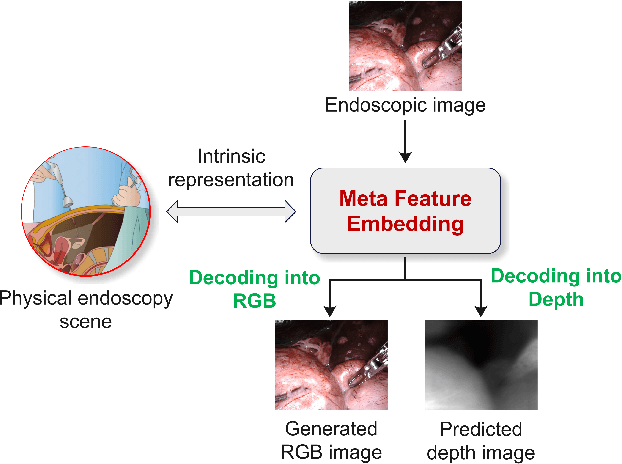

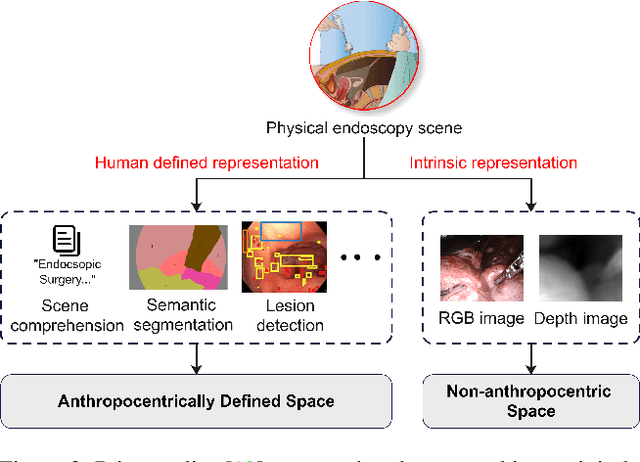

Abstract:Depth estimation from monocular endoscopic images presents significant challenges due to the complexity of endoscopic surgery, such as irregular shapes of human soft tissues, as well as variations in lighting conditions. Existing methods primarily estimate the depth information from RGB images directly, and often surffer the limited interpretability and accuracy. Given that RGB and depth images are two views of the same endoscopic surgery scene, in this paper, we introduce a novel concept referred as ``meta feature embedding (MetaFE)", in which the physical entities (e.g., tissues and surgical instruments) of endoscopic surgery are represented using the shared features that can be alternatively decoded into RGB or depth image. With this concept, we propose a two-stage self-supervised learning paradigm for the monocular endoscopic depth estimation. In the first stage, we propose a temporal representation learner using diffusion models, which are aligned with the spatial information through the cross normalization to construct the MetaFE. In the second stage, self-supervised monocular depth estimation with the brightness calibration is applied to decode the meta features into the depth image. Extensive evaluation on diverse endoscopic datasets demonstrates that our approach outperforms the state-of-the-art method in depth estimation, achieving superior accuracy and generalization. The source code will be publicly available.
FrameFusion: Combining Similarity and Importance for Video Token Reduction on Large Visual Language Models
Dec 30, 2024
Abstract:The increasing demand to process long and high-resolution videos significantly burdens Large Vision-Language Models (LVLMs) due to the enormous number of visual tokens. Existing token reduction methods primarily focus on importance-based token pruning, which overlooks the redundancy caused by frame resemblance and repetitive visual elements. In this paper, we analyze the high vision token similarities in LVLMs. We reveal that token similarity distribution condenses as layers deepen while maintaining ranking consistency. Leveraging the unique properties of similarity over importance, we introduce FrameFusion, a novel approach that combines similarity-based merging with importance-based pruning for better token reduction in LVLMs. FrameFusion identifies and merges similar tokens before pruning, opening up a new perspective for token reduction. We evaluate FrameFusion on diverse LVLMs, including Llava-Video-{7B,32B,72B}, and MiniCPM-V-8B, on video understanding, question-answering, and retrieval benchmarks. Experiments show that FrameFusion reduces vision tokens by 70$\%$, achieving 3.4-4.4x LLM speedups and 1.6-1.9x end-to-end speedups, with an average performance impact of less than 3$\%$. Our code is available at https://github.com/thu-nics/FrameFusion.
Efficient Non-Exemplar Class-Incremental Learning with Retrospective Feature Synthesis
Nov 03, 2024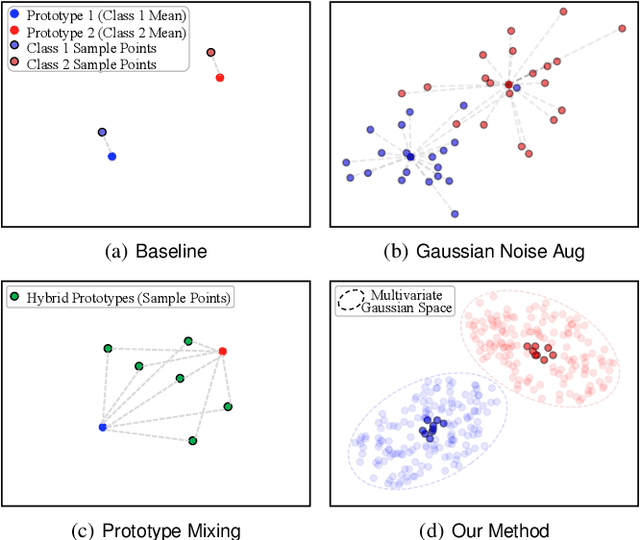
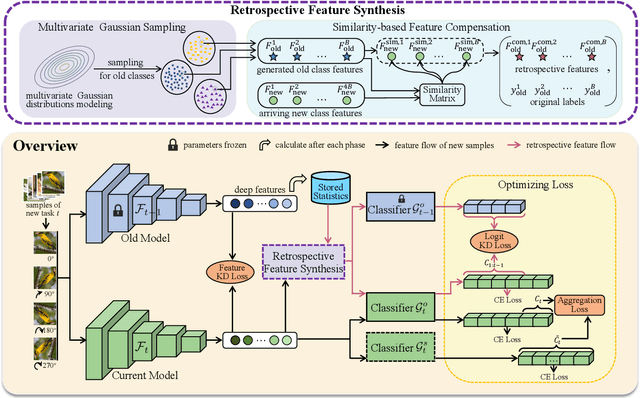
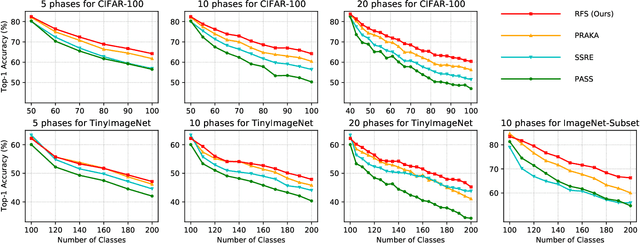
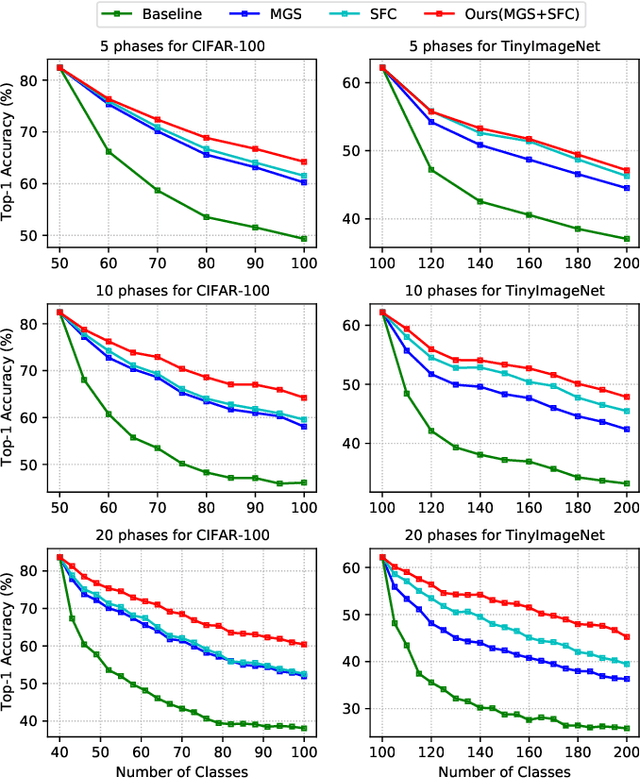
Abstract:Despite the outstanding performance in many individual tasks, deep neural networks suffer from catastrophic forgetting when learning from continuous data streams in real-world scenarios. Current Non-Exemplar Class-Incremental Learning (NECIL) methods mitigate forgetting by storing a single prototype per class, which serves to inject previous information when sequentially learning new classes. However, these stored prototypes or their augmented variants often fail to simultaneously capture spatial distribution diversity and precision needed for representing old classes. Moreover, as the model acquires new knowledge, these prototypes gradually become outdated, making them less effective. To overcome these limitations, we propose a more efficient NECIL method that replaces prototypes with synthesized retrospective features for old classes. Specifically, we model each old class's feature space using a multivariate Gaussian distribution and generate deep representations by sampling from high-likelihood regions. Additionally, we introduce a similarity-based feature compensation mechanism that integrates generated old class features with similar new class features to synthesize robust retrospective representations. These retrospective features are then incorporated into our incremental learning framework to preserve the decision boundaries of previous classes while learning new ones. Extensive experiments on CIFAR-100, TinyImageNet, and ImageNet-Subset demonstrate that our method significantly improves the efficiency of non-exemplar class-incremental learning and achieves state-of-the-art performance.
Double-Shot 3D Shape Measurement with a Dual-Branch Network
Jul 19, 2024



Abstract:The structured light (SL)-based 3D measurement techniques with deep learning have been widely studied, among which speckle projection profilometry (SPP) and fringe projection profilometry (FPP) are two popular methods. However, they generally use a single projection pattern for reconstruction, resulting in fringe order ambiguity or poor reconstruction accuracy. To alleviate these problems, we propose a parallel dual-branch Convolutional Neural Network (CNN)-Transformer network (PDCNet), to take advantage of convolutional operations and self-attention mechanisms for processing different SL modalities. Within PDCNet, a Transformer branch is used to capture global perception in the fringe images, while a CNN branch is designed to collect local details in the speckle images. To fully integrate complementary features, we design a double-stream attention aggregation module (DAAM) that consist of a parallel attention subnetwork for aggregating multi-scale spatial structure information. This module can dynamically retain local and global representations to the maximum extent. Moreover, an adaptive mixture density head with bimodal Gaussian distribution is proposed for learning a representation that is precise near discontinuities. Compared to the standard disparity regression strategy, this adaptive mixture head can effectively improves performance at object boundaries. Extensive experiments demonstrate that our method can reduce fringe order ambiguity while producing high-accuracy results on a self-made dataset. We also show that the proposed architecture reveals the potential in infrared-visible image fusion task.
Hypergraph Multi-modal Large Language Model: Exploiting EEG and Eye-tracking Modalities to Evaluate Heterogeneous Responses for Video Understanding
Jul 11, 2024



Abstract:Understanding of video creativity and content often varies among individuals, with differences in focal points and cognitive levels across different ages, experiences, and genders. There is currently a lack of research in this area, and most existing benchmarks suffer from several drawbacks: 1) a limited number of modalities and answers with restrictive length; 2) the content and scenarios within the videos are excessively monotonous, transmitting allegories and emotions that are overly simplistic. To bridge the gap to real-world applications, we introduce a large-scale \textbf{S}ubjective \textbf{R}esponse \textbf{I}ndicators for \textbf{A}dvertisement \textbf{V}ideos dataset, namely SRI-ADV. Specifically, we collected real changes in Electroencephalographic (EEG) and eye-tracking regions from different demographics while they viewed identical video content. Utilizing this multi-modal dataset, we developed tasks and protocols to analyze and evaluate the extent of cognitive understanding of video content among different users. Along with the dataset, we designed a \textbf{H}ypergraph \textbf{M}ulti-modal \textbf{L}arge \textbf{L}anguage \textbf{M}odel (HMLLM) to explore the associations among different demographics, video elements, EEG and eye-tracking indicators. HMLLM could bridge semantic gaps across rich modalities and integrate information beyond different modalities to perform logical reasoning. Extensive experimental evaluations on SRI-ADV and other additional video-based generative performance benchmarks demonstrate the effectiveness of our method. The codes and dataset will be released at \url{https://github.com/suay1113/HMLLM}.
MoA: Mixture of Sparse Attention for Automatic Large Language Model Compression
Jun 21, 2024
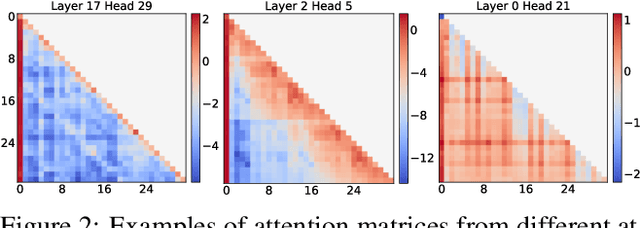


Abstract:Sparse attention can effectively mitigate the significant memory and throughput demands of Large Language Models (LLMs) in long contexts. Existing methods typically employ a uniform sparse attention mask, applying the same sparse pattern across different attention heads and input lengths. However, this uniform approach fails to capture the diverse attention patterns inherent in LLMs, ignoring their distinct accuracy-latency trade-offs. To address this challenge, we propose the Mixture of Attention (MoA), which automatically tailors distinct sparse attention configurations to different heads and layers. MoA constructs and navigates a search space of various attention patterns and their scaling rules relative to input sequence lengths. It profiles the model, evaluates potential configurations, and pinpoints the optimal sparse attention compression plan. MoA adapts to varying input sizes, revealing that some attention heads expand their focus to accommodate longer sequences, while other heads consistently concentrate on fixed-length local contexts. Experiments show that MoA increases the effective context length by $3.9\times$ with the same average attention span, boosting retrieval accuracy by $1.5-7.1\times$ over the uniform-attention baseline across Vicuna-7B, Vicuna-13B, and Llama3-8B models. Moreover, MoA narrows the capability gaps between sparse and dense models, reducing the maximum relative performance drop from $9\%-36\%$ to within $5\%$ across two long-context understanding benchmarks. MoA achieves a $1.2-1.4\times$ GPU memory reduction and boosts decode throughput by $5.5-6.7 \times$ for 7B and 13B dense models on a single GPU, with minimal impact on performance.
Can LLMs Learn by Teaching? A Preliminary Study
Jun 20, 2024



Abstract:Teaching to improve student models (e.g., knowledge distillation) is an extensively studied methodology in LLMs. However, for humans, teaching not only improves students but also improves teachers. We ask: Can LLMs also learn by teaching (LbT)? If yes, we can potentially unlock the possibility of continuously advancing the models without solely relying on human-produced data or stronger models. In this paper, we provide a preliminary exploration of this ambitious agenda. We show that LbT ideas can be incorporated into existing LLM training/prompting pipelines and provide noticeable improvements. Specifically, we design three methods, each mimicking one of the three levels of LbT in humans: observing students' feedback, learning from the feedback, and learning iteratively, with the goals of improving answer accuracy without training and improving models' inherent capability with fine-tuning. The findings are encouraging. For example, similar to LbT in human, we see that: (1) LbT can induce weak-to-strong generalization: strong models can improve themselves by teaching other weak models; (2) Diversity in students might help: teaching multiple students could be better than teaching one student or the teacher itself. We hope that this early promise can inspire future research on LbT and more broadly adopting the advanced techniques in education to improve LLMs. The code is available at https://github.com/imagination-research/lbt.
 Add to Chrome
Add to Chrome Add to Firefox
Add to Firefox Add to Edge
Add to Edge